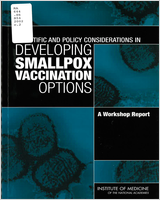NCBI Bookshelf. A service of the National Library of Medicine, National Institutes of Health.
Institute of Medicine (US) Board on Health Promotion and Disease Prevention. Scientific and Policy Considerations in Developing Smallpox Vaccination Options: A Workshop Report. Washington (DC): National Academies Press (US); 2002.

Scientific and Policy Considerations in Developing Smallpox Vaccination Options: A Workshop Report.
Show detailsSeveral additional issues emerged in the general discussion and are briefly summarized below.
Use of Scarce Public Health Resources and Insuring Dual Use Approaches
An immunization program will entail costs, thus decisions must be made about trade-offs. Spending money on a program that would potentially be very effective at addressing a single bioweapons disease might come at the expense of other public health measures that might provide more protection against a broader range of bioagents. However, developing a plan for smallpox response also readies the public health system for other infectious diseases, whether naturally occurring or deliberately spread.
Vaccine Development and Approval
New vaccines will be subject to an IND, which will require the usual protections for those volunteering to be research subjects, including IRB review, informed consent, and data and safety monitoring. By recruiting health care professionals into those trials it might be possible to not only test the vaccine but also potentially immunize a larger ring of individuals who by occupation are not at the highest risk (first responders) but are at greater risk of exposure than the general population. In addition, there should be provisions in the usual IND granting process—if the response is going to be in an emergent situation—to suspend some of the usual procedures and guidelines, or the vaccine will not be delivered.
In testing new vaccines, it will be important to fine tune the dosage and correlate it with the take and reaction. Public response to the clinical reactions experienced by those receiving experimental doses will be important to consider and measure, anticipating that a more risk averse reaction is likely to occur if only the high-dose, more radical reactions are publicized.
For new vaccine development, a vaccine compensation injury fund and indemnification must be available or manufacturers will continue to be wary of conducting R&D in this area.
International Considerations
In developing a smallpox plan for the United States, the ability of the rest of the world to also respond must be considered, especially those countries that have neither the resources nor infrastructure to conduct surveillance and containment or that might face complex cultural challenges in communicating the need for immunization, isolation, or quarantine. In setting domestic vaccine policies, public health officials must also consider what, how, and when the United States makes recommendations to other countries.
Uncertainties
One area of uncertainty in the many public discussions about the vaccination policy options is the risk-benefit ratio. Government officials have said that the risk of an attack is very low, but not zero. The uncertainty of the threat level, the characteristics of the virus that would be used in an attack, and the mechanisms of dispersal make it difficult to evaluate the benefit of the vaccine. Another area of uncertainty is that much of the clinical and epidemiological experience with smallpox infection and the vaccine derive from an era with very different population characteristics than today. Two key differences are the large number of Americans who have no prior immunity to smallpox and the number of people who are immune-compromised.
Communication and Education
The lack of an effective communication strategy can be a significant hindrance to an effective public health response, even with a fairly benign vaccine that is well accepted and without risk. Right now, the assumption is that once the nation sees crucial people getting vaccinated, everyone is going to want to be vaccinated. An alternative possibility is that when people learn about this vaccine through effective public education efforts, they will understand that the vaccine carries risks but they will also understand that if they are exposed, the vaccination is very effective within a few days and there will be enough vaccine for those who need it. A plan should be made for advance notification of the public about the risks and the benefits of the vaccine. Citizens should be encouraged to consider in advance whether vaccination is something they would want to pursue in the event of an outbreak or attack.
An important lesson from the anthrax investigation was the importance of a strong, credible spokesperson. Once the vaccination policy is announced, it is important that it be explained thoroughly to the public, particularly to those who are at risk for adverse effects of vaccination. Depending on the policy decided upon, it will be critical that it be explained not only to those who will receive the vaccine, but also—if the plan does not involve mass vaccination—to those who are not given access.
- PUBLIC COMMENTS AND DISCUSSION - Scientific and Policy Considerations in Develop...PUBLIC COMMENTS AND DISCUSSION - Scientific and Policy Considerations in Developing Smallpox Vaccination Options
Your browsing activity is empty.
Activity recording is turned off.
See more...